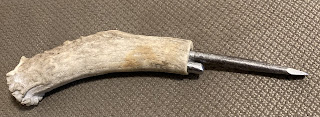If you’ve ever shot a flintlock musket you find how how useful a screwdriver is real quick. For a fusil de chasse (literally a hunting gun) of the mid 18th century it is impossible to adjust the flint its self without one. If you don’t have a screwdriver forget about doing anything to the lock at all. I haven’t seen screwdrivers on any lists of items issued to milice.
The screwdriver I currently use is from a hand forged set. Very accurate in its material and construction but I don’t think it’s reproduced from an artifact with a New France provenance or a specific artifact. Anyway it’s always good to have an extra screwdriver lying around.
I did find an original artifact in the Fort Ticonderoga digital collections dated between 1750 and 1850.
It is a small, simple screwdriver made from two steel rods driven into a cut piece of an antler shed. Seemed like the kind of thing that would be very useful to me while adjusting my fusil de chasse. It seemed simple enough.
Artifact MC466 Fort Ticonderoga Online Collections
This artifact has a wide possible date range and it’s notes on the website don’t tie the artifact to New France specifically. BUT, it’s an artifact with a possible new France context made from available materials and would be useful to someone using a musket.
The only dimensions for the item on the website was that the width is 3.17 cm. So I emailed the museum for the dimensions and the VP of Collections and Digital Productions was able to provide me with the dimensions :5.75" long and the widest point of the handle is 1.5" and the narrowest is 1.25". Thank you to them for the dimensions!
I had an old piece of antler from a harvested deer lying around that was just about the same width. I trimmed it down the length to fit my hand with a hand saw. Then I hand bored two holes, one for the screwdriver head and a second adjacent hole to drive in a small pice of steel rod to secure the head in and wedge the bit into the handle. Doing this with a hand cranked drill and no vice was time consuming and difficult.
I had an old broken screwdriver and removed the rest of the broken wooden handle. The bit was longer than I wanted, I attempted to saw it off with a hack saw. This did not work well so I used the corner of a square file to file into and snap off two lengths, one shorter and one longer for the bit and it’s wedge. Again using hand tools and no vice, this was time consuming.
I then lightly tapped the rods into the holes I bored into the antler and added a small amount of glue.
This process taught me that someone without the necessary tools to cut steel and drill into antler would need to dedicate a large amount of spare time to its creation.
The museum artifact seems home made and somewhat crude. My reproduction matches this esthetic. In the spirit of conservation I used a harvested deer antler that I had on hand rather than attempt to find an antler shed like the original artifact. Because I cut the antler to length to fit my hand my reproduction is around 1/4 of an inch longer than the original at 6 inches long.
My conclusions are that it is possible with a file, hand drill and some time on your hands to make a comparable screwdriver to the one in the museum collection.
I also think that the piece could have been sentimental to the owner if they were also the creator of the object. Finding an antler shed is rare and working with antler and steel with crude materials is time consuming. Boredom could be another explanation. Although dramatic events happened there, life at the fort on Lake Champlain was probably a little slow most of the time. A wood handle would be much faster and simpler to create. I will say that it has produced what I see to be a very durable tool. Antler is very hard and the steel bit is very strong and will not bend.
The design is aesthetically pleasing and I assume rare enough that its owner would be able to verify that it belonged to them if lost or stolen.
Overall, I love the screwdriver and I’m excited to field test it. I think it’s an item a milicean could have produced and brought from home or produced while waiting to leave on another march.










No comments:
Post a Comment